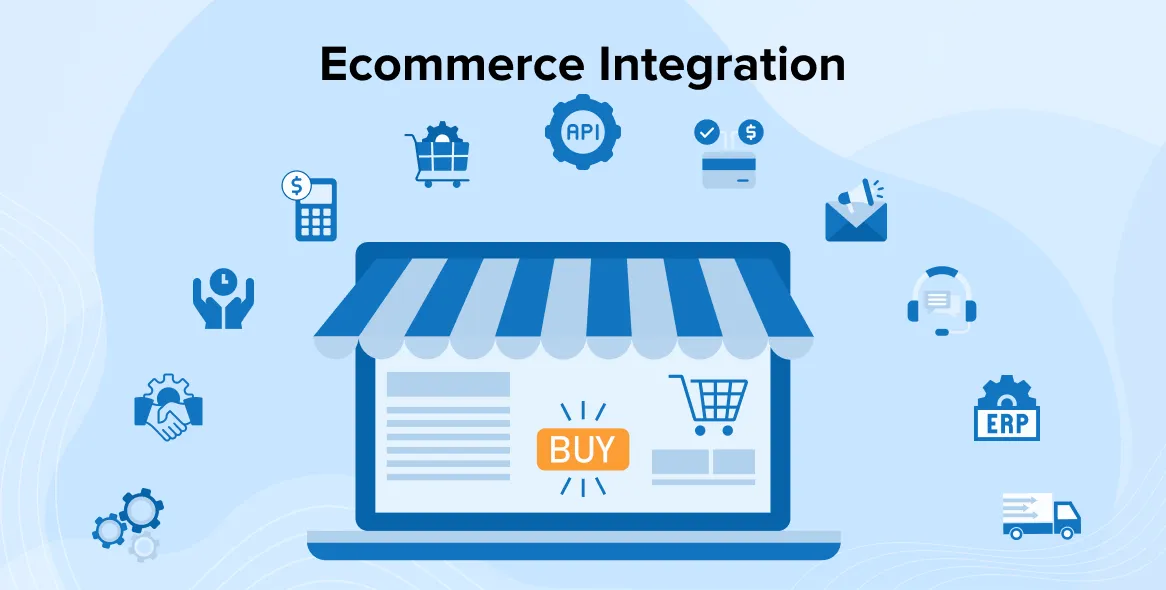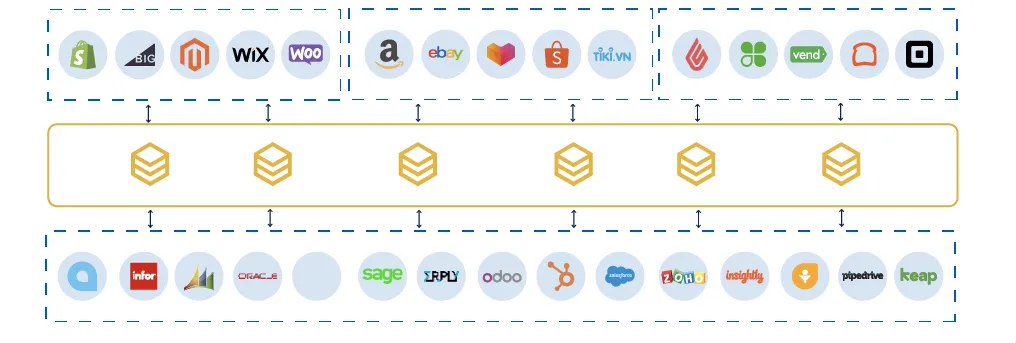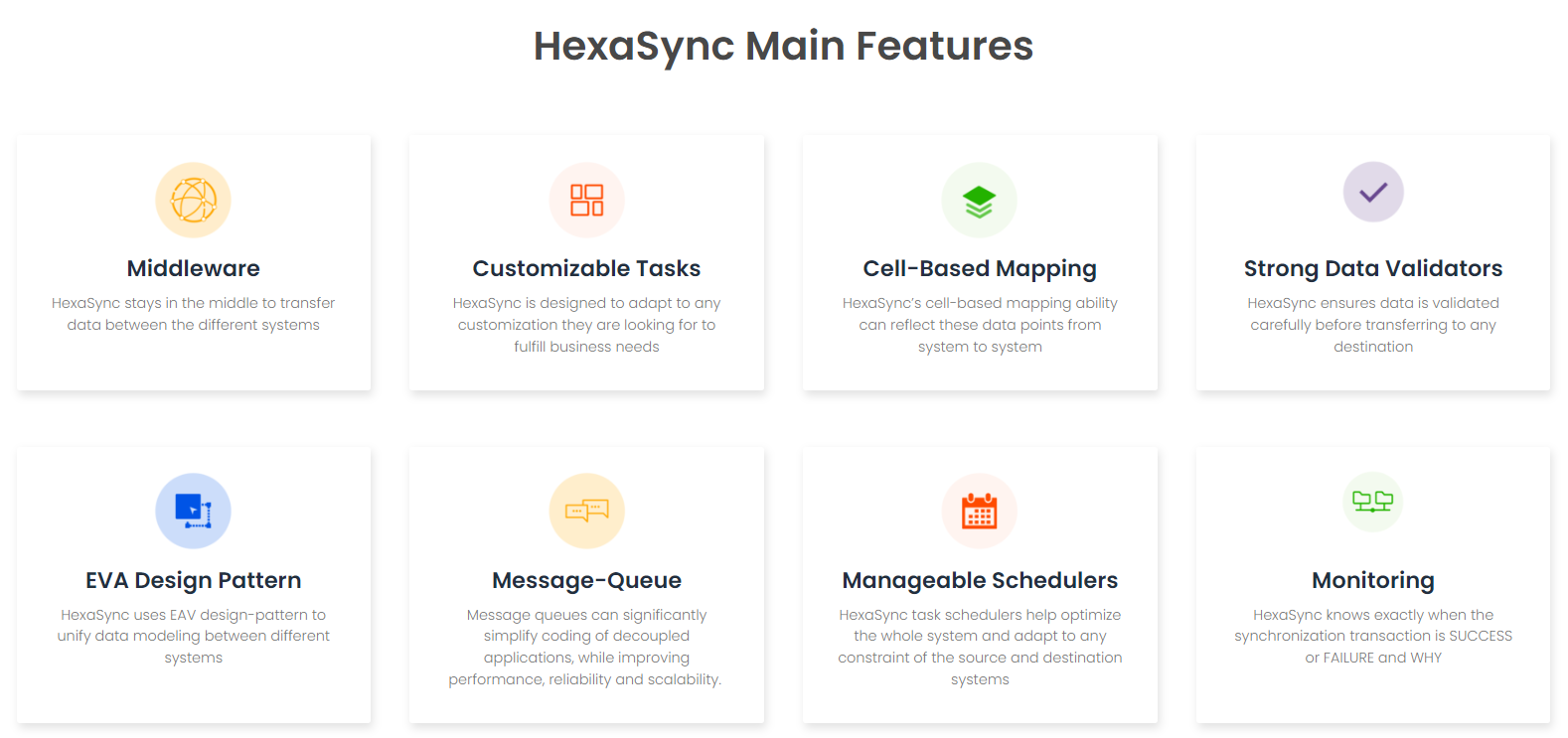In today’s digitally driven market, the fusion of various business systems through eCommerce integration has become a cornerstone of success. But what exactly is eCommerce integration? This article will explore the intricacies of eCommerce integration, its types, benefits, and why it’s an indispensable tool for modern businesses aiming to thrive in the online marketplace.
Understanding the Basics of eCommerce Integration

eCommerce integration is the process of syncing your online store with other business systems such as inventory, accounting, CRM, and ERP systems. It enables automated data exchange between systems, eliminating the need for manual data entry and reducing errors. The ultimate goal is to streamline operations, enhance customer satisfaction, and boost sales.
So, why organizations need eCommerce integration?

Businesses today face the critical need for eCommerce integration to remain competitive and responsive in the fast-paced digital marketplace. The integration of eCommerce platforms with backend systems offers a multitude of advantages, including automated data transfer that reduces manual errors, streamlined operations that lower costs, and enhanced customer experiences through real-time inventory updates and personalized services.
Additionally, eCommerce integration provides valuable insights into customer behavior and sales trends, empowering businesses to make informed decisions. By bridging the gap between various business processes and technologies, eCommerce integration ensures that businesses operate more efficiently, adapt quickly to market changes, and ultimately drive growth.
Some eCommerce integration uses cases
Organizations across different sectors leverage eCommerce integration to transform their operations and enhance customer experiences. Walmart, for example, has developed a seamless omnichannel shopping experience by integrating its online and physical stores with inventory and supply chain management systems. As a result, it allows customers the flexibility to shop in a way that suits them best, whether online, in-store, or through home delivery, optimizing inventory and logistics.
Besides, Unilever, the consumer goods company, harnesses eCommerce integration to analyze customer data across platforms, tailoring marketing, product development, and customer service to meet diverse needs. This data-driven approach enhances customer loyalty and boosts sales.
Similarly, Starbucks integrates its loyalty program with its mobile app and eCommerce platform, rewarding customers for in-store and online purchases. This unified approach encourages repeat business and provides valuable insights into customer preferences.
Lastly, Airbnb’s integration of various payment systems facilitates secure and straightforward transactions for its global user base. It ensures a smooth booking process, supports multiple currencies, and builds trust among its community.
These examples underscore the strategic value of eCommerce integration in streamlining operations, improving customer engagement, and driving growth, showcasing its necessity in today’s digital marketplace.
Types of eCommerce Integrations

eCommerce integration is a crucial aspect of modern business operations, enhancing efficiency, and providing seamless customer experiences. Among the various types of eCommerce integration, four stand out due to their impact on business processes and customer service: eCommerce POS integration, eCommerce CRM integration, eCommerce ERP integration, and eCommerce accounting integration. Each type addresses specific business needs, and collectively, they form the backbone of a comprehensive digital strategy.
Integrating eCommerce with POS systems
eCommerce POS integration focuses on bridging the gap between online sales channels and physical stores. It allows for real-time inventory management, ensuring that stock levels are updated instantly across all sales channels whenever a purchase is made, either online or in-store. This synchronicity prevents stock discrepancies, enhances customer satisfaction by providing accurate stock information, and enables omnichannel strategies where customers can buy online and pick up in-store, or return online purchases at a physical location.
Some profiles of eCommerce POS integration:
- Shopify Quickbooks POS integration
- Shopify Odoo POS integration
- Shopify Lightspeed POS integration
- BigCommerce Clover POS integration
- Wix Square Integration
Integrating eCommerce with CRM systems
eCommerce CRM integration is about centralizing customer data from various touchpoints into a single system. This integration offers a unified view of customer interactions, purchase history, and preferences, which can be leveraged to personalize marketing efforts, improve customer service, and increase customer loyalty. By understanding customer behavior and preferences, businesses can tailor their offerings and communications to meet customer needs more effectively.
Some profiles of eCommerce CRM integration:
Integrating eCommerce with ERP systems
eCommerce ERP Integration connects the eCommerce platform with an enterprise’s core operational systems, including inventory management, order processing, supply chain management, and finance. This holistic integration streamlines business processes, automates workflows, and provides real-time visibility into operations. It enables businesses to manage their resources more efficiently, reduce operational costs, and make informed decisions based on comprehensive data analytics.
Some profiles of eCommerce CRM integration:
- Shopify Dynamics 365 F&O integration
- Shopify Netsuite integration
- BigCommerce SAP B1 integration
- BigCommerce Infor Syteline integration
- Wix Acumatica integration
- Adobe Dynamics 365 Business Central integration
Integrating eCommerce with Accounting Systems
eCommerce accounting integration simplifies the financial management aspect of online sales. By automatically transferring sales data to accounting software, this integration reduces manual data entry, minimizes errors, and ensures financial records are always up-to-date. It supports better financial reporting, tax compliance, and cash flow management, allowing businesses to focus on strategy and growth rather than administrative tasks.
Some profiles of eCommerce accounting integration:
Integrating eCommerce with Marketplace
eCommerce Marketplace Integration enables businesses to manage their presence across platforms such as Amazon, eBay, Etsy, and Walmart from a single dashboard. It streamlines inventory management, and order processing, and ensures consistent brand visibility while providing insights into sales and customer behavior. This integration is crucial for expanding online reach and optimizing sales efficiency in today’s competitive digital landscape.
Some profiles of eCommerce marketplace integration:
- Shopify eBay integration
- Shopify Walmart integration
- WooCommerce Tiktokshop integration
- WooCommerce Amazon Integration
- Adobe Amazon Integration
How to connect an eCommerce platform with other business systems?
Connecting an eCommerce platform with other business systems can be achieved through various methods, each offering its advantages.
One common approach is the use of APIs (Application Programming Interfaces), which allow for seamless data exchange between the eCommerce platform and external systems such as CRM (for example – Creatio CRM software, Zoho CRM, Hubspot CRM), ERP, or accounting software.
Another method involves middleware solutions that act as intermediaries to facilitate communication between disparate systems.
Additionally, many businesses opt for pre-built integrations offered by their eCommerce platform or third-party vendors, which provide plug-and-play solutions for common integrations within the eCommerce community.
Lastly, custom development might be necessary for unique or complex integration needs, requiring a tailored approach to ensure compatibility and efficiency.
Choosing the right method depends on the business’s specific requirements, resources, and goals, aiming for a solution that enhances operational efficiency and improves the overall customer experience.
Transforming your business with the HexaSync integration platform

HexaSync is a global iPaaS vendor that helps organizations connect eCommerce with other systems, such as POS, CRM, ERP, accounting, or marketplace, to automate business processes.
It works as middleware to help organizations connect and integrate legacy systems with modern SaaS applications via APIs and access tokens. Using HexaSync, users can monitor the flow of data transfers from the source location to the destination location. So, they can detect the problems and solve them if they are not technical. You can integrate with hundreds of applications, such as Shopify, Magento, BigCommerce, Salesforce, Hubspot, Microsoft Dynamics 365, and many others, to automate business workflows.
Key Features
- Middleware: HexaSync stays in the middle to transfer data between the different systems
- EAV Design Pattern: HexaSync uses an EAV design pattern to unify data modeling between different systems
- Cell-Based Mapping: Help reflect any kind of data points from system to system
- Message Queue-Based Architecture: HexaSync simplifies the coding of decoupled applications and provides better performance, reliability, and scalability
- Customizable Tasks: HexaSync is designed to adapt to any customization they are looking for to fulfill business needs
- Monitoring: HexaSync knows exactly when the synchronization transaction is SUCCESS or FAILURE and WHY
- Manageable Schedulers: HexaSync task schedulers help automate everything we need.
Conclusion
In conclusion, eCommerce integration solutions can help businesses streamline operations, improve customer experiences, and gain better data insights. Whether utilizing APIs, middleware, pre-built connectors, or custom solutions, each method offers a pathway to enhance operational efficiency and competitiveness in the digital marketplace. If you need to connect your eCommerce platform with another system, please give us your email.